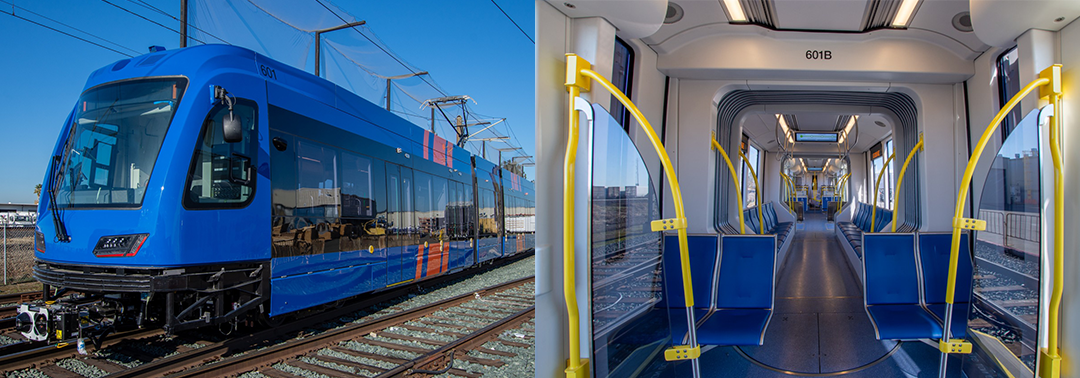TriMet Light Rail Gets Wi-Tronix Upgrade
December 14, 2022

A digital transformation is underway in Portland
Portland’s TriMet, the largest regional transit provider in Oregon, is moving full steam ahead as it adopts the latest digital technology to bring to life its vision for leading-edge light rail vehicle (LRV) service. A successful pilot project demonstrated the advantages TriMet is gaining by digitalizing its rail fleet with Siemens Railigent and Wi-Tronix Violet IoT solution applications. The first LRVs in line for this digital transformation are the 26 new S700 low-floor vehicles from Siemens Mobility that are being delivered with the applications installed and ready to go. Four additional vehicles have also been purchased by TriMet, for a total of 30 new MAX trains on their rail system beginning in 2023.
“Digitalizing our rail fleet provides us the opportunity to really get to predictive or preventive maintenance. The tools are now there, and the data is now there, and we’re entering a paradigm shift now that’s going to get us there,”
A.J. O’Connor, TriMet’s Director of Intelligent Transportation Systems
Real-time information simultaneously improves operations and maintenance
TriMet is a long-time proponent of using data to make the best decisions that help serve its customers effectively and efficiently. Since the agency ordered its first Siemens LRVs in 1995, TriMet and Siemens Mobility have worked closely to develop solutions that drive passenger loyalty and growth. This deployment of Siemens and Wi-Tronix applications will digitalize the LRVs and deliver near real-time data and insights TriMet can use to improve operations and maintenance. As more LRVs are equipped with the digital technology, Siemens and Wi-Tronix will deliver insight reports to TriMet that collect data from across the fleet to form in-depth conclusions. The Siemens Railigent applications provide up-to-the-minute fleet monitoring, enhanced data analytics and transit operational insights. Siemens ongoing monitoring helps maintain schedules and supports operator training. Siemens remote diagnostics will help TriMet move from reactive to condition-based and predictive maintenance. Wi-Tronix applications deliver automatic live-streaming of real-time vehicle location and speed, as well as position, operational data, and behavioral identification of alerts. The Wi-Tronix system also provides real-time signal views including raw data, pressures, and gauges for optimized monitoring. Combined, the Railigent and Wi-Tronix applications position TriMet to deliver a better rider experience, with greater on-time performance and fewer equipment breakdowns that take vehicles off-line.
“Through Railigent and Wi-Tronix deployment, we are able to get real-time access to data on the vehicles that was previously difficult or not attainable.” Said A.J. O’Connor, TriMet’s Director of Intelligent Transportation Systems, “During one post-incident review, we were able use Siemens Software-as-a-Service to pull data about everything the car did. It proved extremely useful.”
Transit Signal Priority keeps LRVs on schedule
Transit Signal Priority (TSP) isn’t just for buses anymore. Since the new digital technologies are moving data to the cloud, TriMet is working with Siemens Mobility and Wi-Tronix to pilot a cloud-based TSP program for LRVs. In the past, the type of signal preemption used for fire trucks and police was the only option for LRVs. But that often-caused traffic to back up on side streets. The connected vehicle will constantly send its updated location information to the cloud, providing access to real-time data that will make TSP more intelligent. The traffic signal system at an intersection will receive a more accurate arrival time for the LRV, allowing smoother signal operation that prevents traffic jams.
“Cloud-based, intelligent TSP will handle traffic very seamlessly to anybody that’s using that intersection and can keep our LRVs going without interrupting other traffic flow.”
A.J. O’Connor, TriMet’s Director of Intelligent Transportation Systems
Addressing every need through the, Siemens Xcelerator, Railigent ecosystem, & Wi-Tronix Violet IoT Solution
Siemens Xcelerator incorporating Railigent for transportation uses standard application programming interfaces (APIs), allowing easy access to a suite of apps that employ the Internet of Things (IoT) and Artificial Intelligence (AI) to make use of rail asset data more intelligent. Siemens Mobility created Railigent ecosystem to encourage leading specialists in digital rail services and our customers to create their own applications or leverage those developed by others for the marketplace. Wi-Tronix’s Violet IoT solution delivers actionable information and insights on how networks are performing in real-time with artificial intelligence (AI)-managed updates & onboard application programming interfaces (APIs). By enabling continuous improvement with a powerful combination of connectivity, analytics, alerts, and more, Wi-Tronix enables freight and passenger railroads and transit systems with the tools that help enhance safety, sustainability, operational efficiency, and service reliability. TriMet engineers will be able to use the data gathered by the Railigent and Wi-Tronix Violet IoT applications to create custom software to support their operations. No stranger to application development — its engineers developed two applications used by transit agencies around the world — TriMet plans to use the open system to create new applications for their LRVs that leverage existing programs used by the agency.
An Xcelerator partnership that keeps Portland moving
TriMet’s relationship with Siemens extends back to 1995 when the agency ordered 46 low-floor LRVs, the first to be used in the U.S. Currently, Siemens Mobility is manufacturing and delivering 30 of our latest state-of-the-art low-floor LRVs developed jointly with TriMet. Siemens Mobility is also providing mid-life overhaul services for 79 TriMet LRVs that include adding current technology and functionality for improved customer experience.
